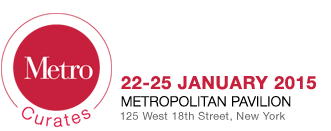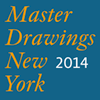We are very pleased to announce that two Pratt lounges will be featured at this year's METRO Show. The lounges were designed by a team of faculty, undergraduate and graduate students from the Department of Interior Design at Pratt Institute in Brooklyn, NY, which is committed to social and environmental responsibility. More
 |
From Homespun to Hallucinogenic in Two Fairs |
| http://www.nytimes.com/2013/01/25/arts/design/metro-show-and-editions-artists-book-fair.html?_r=0 Metro Show and Editions/Artists’ Book Fair Don’t be fooled by the name. The Metro Show, the art and antiques fair going on this week at the Metropolitan Pavilion in Chelsea, is not a display of sophisticated urbanity. A two-year-old reincarnation of the event formerly known as the American Antiques Show, it does feature 34 dealers trafficking in an extraordinarily wide range of materials, from ancient Andean textiles at William Siegal’s booth to a wooden model of a French World War II fighter plane created for wind tunnel testing, which is at Bernard Goldberg.
In its heart and soul, however, the fair is the opposite of urbane. Abounding in works by unknown folk artists and self-taught outsiders like Bill Traylor and Joseph Yoakum, it invites the visitor down a rabbit hole of American imagination untamed by conventional training.
An electrifying quilt at Stephen Score’s booth, dated 1897 and initialed E.E.V. in one corner, is emblematic. Its unknown creator made a mandala composition of pulsating circles of different sizes in colored and patterned fabrics. The whole is embroidered by hand all over in off-white thread, which outlines the circles and interjects stars, glyphic signs and straight and curvy lines that give the impression of a universe animated by divinely transmitted electromagnetic radiation.
Here and there are works by obviously educated artists. In addition to the model airplane Bernard Goldberg has an incandescent painting by the American Modernist Marguerite Zorach called “Night Still Life” (1940). Made with vigorous, broad strokes, it depicts a white and blue pitcher holding a multicolored bouquet of flowers on a window sill framed by yellow curtains. It is like a secular altarpiece infused by both earthly and transcendental energies.
Less salubriously the Pace Prints booth offers large, technically complex prints by famous Modernist artists like Frank Stella and Helen Frankenthaler. Such mainstream work seems gratingly incongruous in this context, but elsewhere interesting dialogues between insiders and outsiders emerge. The Hill Gallery booth has a 1993 painting of a nude model by the professional realist Philip Pearlstein facing a pair of comically chubby but lordly lions carved from stone by an unknown 19th-century artisan. The immense leap between such different styles and sensibilities is curiously thrilling to behold. Hill also has a life-size and amazingly lifelike sculpture of a suave gentleman dressed in 18th-century fashion carved from Southern pine early in the 19th century. Presumably once stationed at the door of a plantation owner’s mansion, this dandified fellow leans forward to greet you with almost frightening eagerness. His realism calls to mind limewood carvers of late medieval Germany. Carl Hammer has a fine selection of works by 20th-century eccentrics, including “View of Athens” by the self-taught painter Drossos P. Skyllas, in which the Parthenon on its mountaintop and other white buildings surrounded by dense forest below are seen with hallucinogenic intensity. Equally otherworldly but in a different way are heavily worked watercolors by Charles A. A. Dellschau (1830-1923). A Houston butcher, Dellschau devoted his free time to envisioning fanciful airships like ones you might see in a Terry Gilliam movie. A selection of these mysterious works is at Stephen Romano. In a more down-to-earth mode H. Malcolm Grimmer has an excellent show of drawings from a recently discovered Sioux ledger book from about 1880. Anonymous Plains Indians carefully drew these scenes of hunting, fighting and courting in pencil and crayon on oblong rectangles of lined paper in books supplied by United States military personnel. They were concerned not with imaginary visions but with documenting the history of their tribes. So while there is a degree of abstraction that appeals to modern eyes, there is also an emotionally gripping, real-life specificity. In the decorative arts category there are many works of uncommon inventiveness and craftsmanship. Along with lots of pieces of Tramp Art, Clifford A. Wallach has a lamp made by an early 20th-century Maine woodworker. Its intricately patterned body and shade are marvels of homespun marquetry. Three smoothly carved little birds, two on the base and one at the top, add irresistibly sweet accents. Running concurrently with the Metro Show in another part of the Metropolitan Pavilion is a distinctly different exhibition, the Editions/Artists’ Books Fair. Devoted primarily to producers of contemporary prints and books, this show has a spirit that leans decidedly toward urbane sophistication. The fair’s more than 50 exhibitors also suggest that the arts of mechanical reproduction are enjoying a new golden age as artists and artisans take advantage of all kinds of technologies new and old. Working in traditional mediums of etching and lithography, Nicole Eisenman has been involved in an irreverent yet evidently consuming conversation with Picasso, the 20th century’s greatest graphic artist. Her comical images of people in seedy bars and other downbeat situations rendered in an insouciantly contradictory variety of styles are displayed at Jungle Press Editions. Novice collectors should take note. Cheap works can be acquired at many booths, including Cannonball Press’s, whose proprietors, Mike Houston and Martin Mazorra, create punchy, black-and-white relief prints combining sensational imagery and texts resembling posters for cheesy movies like one called “Summer of Lust.” You can take home a single print for $20 or five for $80. That is a good deal. The Metro Show and the Editions/Artists’ Book Fair run through Sunday at Metropolitan Pavilion, 125 West 18th Street, Chelsea; (800) 563-7632, metroshownyc.com. |
| http://www.nytimes.com/2013/01/25/arts/design/metro-show-and-editions-artists-book-fair.html?_r=0 |
 back to press coverage back to press coverage |





